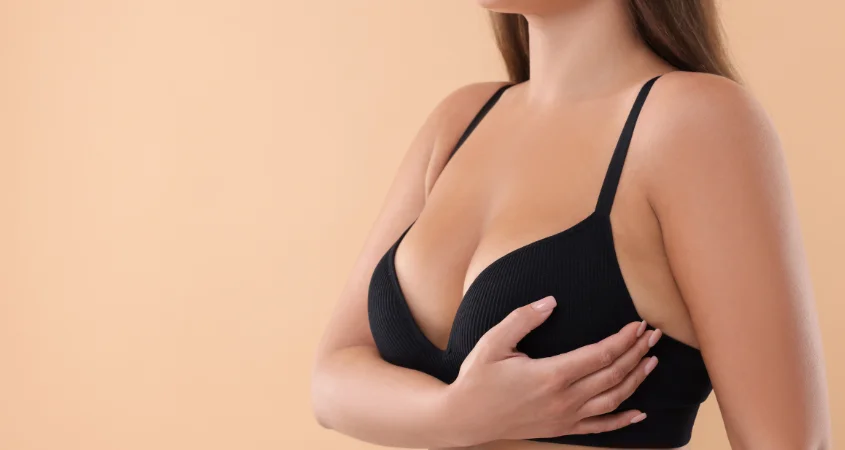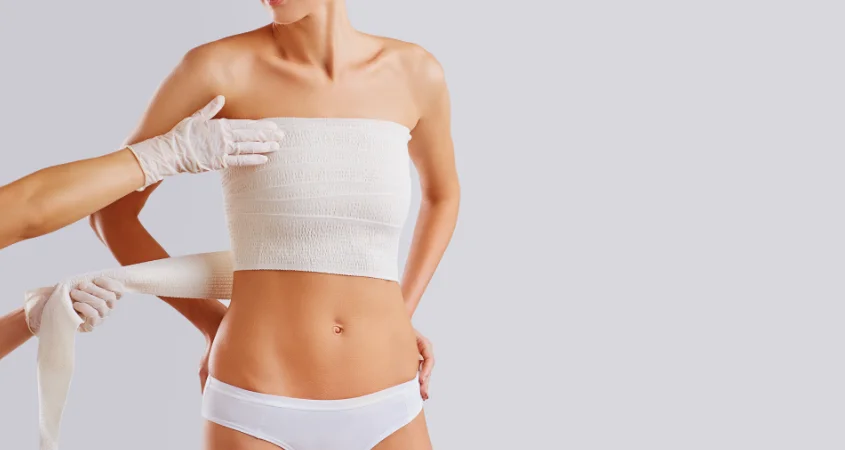Natural Looking Breast Augmentation
By Partington Plastic Surgery on May 01, 2024 in Breast Augmentation, Breast Implants

Foundations of Natural-Looking Breast Augmentation Procedure
Defining Natural Looking Breast Augmentation
In breast augmentation, “natural” means more than appearance. It takes a holistic strategy to achieve results that are both attractive and proportional to the patient. A “natural” augmentation involves assessing the dimensions, inherent form, and positioning of the implant to align with the individual’s physique and prevent an excessively artificial appearance. This is the method by which plastic surgeons attain the appearance of authentic breasts. Movement and sensation matter too. Enhanced breasts must resemble the bounce and softness of unenhanced breasts to be as lifelike as feasible. This delicate treatment requires a skilled surgeon who can adapt to the patient’s anatomy and goals.
Consideration is given to the long-term effects of breast augmentation that appears natural. Patients must have realistic expectations and recognize that implants are transient. It is crucial to select a measurement that appears natural, given that the body changes with age.

Safety should be considered with breast augmentation’s beauty and lifespan. Health should not be sacrificed for natural results. Before surgery, patients should be advised of potential complications and weigh their breast augmentation options. This involves discussing pre-existing medical issues, previous surgeries, and lifestyle factors that may affect the surgery.
Natural-looking augmentation should also improve physical and emotional health. Patients should prepare psychologically and physically for surgery, have realistic recovery expectations, and live a healthy lifestyle afterward. Patients must feel secure in their breast augmentation decision and have a positive body image.
The Importance of Proportion and Symmetry of Breast Implants
Balance and symmetry are essential for cosmetic and reconstructive surgery to look natural. Surgeons carefully evaluate these factors during planning by utilizing physical examination and sophisticated imaging.
This assessment helps them comprehend each patient’s unique anatomical composition and create a specific surgical strategy to enhance natural characteristics and fix imbalances. To achieve cosmetic improvement and a more natural appearance, upgrades should match bodily proportions. Careful planning balance and symmetry distinguish successful surgical outcomes, boosting patient pleasure and confidence.
The Anatomy of the Breast
Comprehending the Natural Structures and Tissues of the Breast
The breast’s anatomy is multifaceted, consisting of numerous structures that are integral to both its functionality and visual appeal. In the context of breast augmentation, two critical factors hold notable importance: the density of the breasts and the elasticity of the epidermis.
Denser breasts may require different surgical techniques or implant types to achieve desired outcomes. Understanding these anatomical elements is essential for tailoring augmentation procedures to individual needs, ensuring safety and satisfying results.
Natural Look
Confident Beauty
24 Hour Rapid Recovery, Muscle Sparing.

How Anatomy Influences Augmentation Choices
The patient’s anatomy and physiological needs determine implant kinds, sizes, and surgical methods. The best implant type and size depend on each patient’s bone density, muscle mass, and skin elasticity. Surgeons carefully consider these aspects to match implants to the patient’s natural proportions for optimal usefulness and aesthetics.

The patient’s anatomical details are considered while choosing a surgical approach to minimize tissue damage and speed healing. This tailored approach boosts patient happiness and surgery lifespan and success.
Technology and materials have expanded implant choices, allowing patients to customize their treatments. Silicone breast implants, textured, smooth, round implants, and anatomical breast implants must be considered when choosing an implant for a patient.
On top of implant selection and surgical technique, post-operative care is vital to success. Surgeons provide post-operative recommendations to reduce problems and enhance recovery. Physical activity restrictions, wound care, and progress visits may be required. Patient recovery and long-term results improve with good post-operative care.
Types of Breast Augmentation
Silicone Breast Implants: Pros and Cons
Silicone implants have gained popularity due to its ability to replicate the texture and appearance of genuine breast tissue, a crucial factor for those seeking the most authentic breast augmentation experience.Their gentler and more realistic appearance makes them popular among patients and physicians.
Fat Transfer Breast Augmentation Surgery
Fat transfer, or fat grafting, is a natural alternative to implants. This procedure involves taking fat from one body region and enhancing another region. This minimally invasive technique includes liposuctioning fat from the belly or thighs, purifying it, and injecting it into target locations like the face, breasts, or buttocks. Ideal applicants have enough fat stores for extraction and want a natural look or want to avoid synthetic components. Its attraction is its decreased rejection risk and promise for more subtle, natural-looking outcomes by using body fat.

As more individuals seek natural ways to look better, fat transfer has grown in popularity. This method avoids synthetic materials and reduces the possibility of problems or rejection.
Plastic surgeons must do fat transfer carefully in numerous phases. Liposuction collects extra fat by performing tiny skin incisions and sucking out fat cells using a specific instrument. This phase eliminates fat and shapes the region for a sculpted look.
Alternative Methods and Innovations in Breast Augmentation Surgery
The promotion of natural breast augmentation procedures is being facilitated by advancements in medical research and technology. The process of fat transfer enhances the size of the breasts, leading to a more genuine visual and tactile experience. The application of innovative biomaterials that mimic the properties of human tissue holds promise for transforming traditional breast augmentation procedures, providing improved safety, prolonged longevity, and decreased occurrence of problems. The field of cosmetic surgery is witnessing a growing trend towards more individualization and biocompatibility.
Social acceptance of varied body shapes and body positivity have also increased demand for natural looking breast augmentation. Large, conspicuous breast implants are no longer the sole way to improve one’s look.
More women are seeking minor improvements to compliment their natural curves and physiques as self-love and appreciating one’s unique qualities rise. This societal change has made most natural breast augmentation procedures more popular since they are more discreet and adaptable.
Surgical Techniques for Natural Looking Results
Incision Techniques
The inframammary approach, which provides precise implant implantation through direct access to breast tissue, necessitates the creation of an incision in the fissure beneath the breast. Typically, this technique produces an incision that is concealed by the natural breast crease, thereby reducing its visibility. It is compatible with the majority of breast augmentation techniques and has a negligible effect on the capacity to breastfeed after the procedure.

The Periareolar approach involves an incision made around the lower half of the areola, blending the scar with the natural transition in skin color and texture at the edge of the areola. This method can offer good access for implant placement and is particularly advantageous for certain procedures such as a breast lift combined with augmentation. However, it carries a slightly higher risk of affecting nipple sensation and may impact breast-feeding.
Lastly, the Transaxillary approach involves an incision made in the natural fold of the armpit, through which the implant is inserted and positioned. The primary advantage of this method is that it leaves no scars on the breast itself, with the scar hidden in the armpit. This technique requires precision and may be performed with the assistance of endoscopic equipment. It’s less commonly used due to its technical demands and limitations in implant placement control.
Natural Looking Breast Implants Placement and Selection
Over vs. Under the Muscle: Impacts on Natural Appearance
Individuals desiring a more obvious augmentation may chose subglandular implants, which are put above the muscle and seem rounder. Submuscular or dual plane insertion allows the muscle to cover the implant, creating a more progressive breast profile slope and a more natural bounce and feel. This approach hides implant edges, making it useful for patients with less natural breast tissue. Submuscular insertion reduces the chance of capsular contracture, which hardens the scar tissue around the implant, and may make mammography screenings easier. Due to muscle manipulation, under-the-muscle implantation recovery may be more painful and lengthy. Before choosing, consult a board-certified plastic surgeon about the benefits and downsides of each implantation choice.
Conclusion
It is crucial to engage in meticulous preoperative planning, establish practical expectations, and conscientiously adhere to post-operative directives in order to attain breast augmentation outcomes that appear natural. Understanding what “natural” entails in the context of breast augmentation is the first step, emphasizing the importance of proportion, symmetry, and how well the augmentation complements the individual’s body.
The choice between silicone implants or the alternative of fat transfer, should be made considering the advantages and drawbacks of each, in consultation with a board-certified surgeon whose credentials and experience align with the patient’s goals.
The selection process should be informed by a deep understanding of one’s anatomy, as this directly influences implant type, size, and placement decisions. The selection of surgical methods, such as the incision method and the placement of the implant either over or beneath the muscle, are pivotal factors in attaining a visually authentic outcome.
Post-operative care is just as critical as the surgery itself, with immediate and long-term care plans designed to support the healing process and maintain the augmentation’s natural look over time. Lifestyle adjustments and an awareness of how aging might impact the results are necessary to preserve the augmentation’s appearance.
In summary, achieving a natural-looking breast augmentation result is a comprehensive process that requires careful consideration, expert guidance, and a commitment to following through with recommended practices before, during, and after surgery.
At Dr. Partington’s plastic surgery clinic, you can get quality advice and natural-looking breast augmentation services. Our patients’ testimonials always speak better than we can tell you. And, therefore, you can be sure of the quality of our services.
Return to Overview